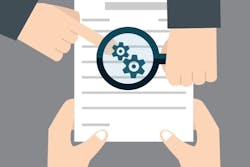Having another pair of eyes look over your repair plans can improve accuracy, reduce cycle time and increase profitability. Shop operators know this, which is why the development of repair plans involving vehicle disassembly prior to repair have become widespread in recent years. But a repair plan is only as good as it is accurate.
That’s why Brian Evison, the technical director for collision repair consulting firm Bemack Planning Services Inc., has been working with shops to routinely review, or audit, their repair plans. It’s a practice that ultimately leads to improved accuracy, profitability and customer service for both vehicle owners and insurance partners, he says. Evison discusses the steps every shop can take to properly audit its own repair plans.
I have many clients who have implemented new processes and procedures, but ensuring they are being followed and producing the desired results is the key to understanding their value. My advice is always the same: If you can’t find a way to tangibly and objectively measure it, the change probably wasn’t worth making in the first place.
This is no different with repair planning. In my experience, a walk through to observe whether procedures are being followed typically isn’t enough. People are usually more inclined to do the right thing when they know they are being observed. Their ongoing commitment to follow the procedures is not so easy to witness from a snapshot of time. That’s why completing regular process audits is so important.
Auditing takes minimal time considering the potential errors it eliminates. Completing an audit usually takes no more than 15 minutes, and even less time to complete a self-auditing checklist. It is key to have a shop culture where people understand why it is important to complete a thorough and accurate estimate. If they know why and buy into the process, then they won’t just check a box on a list to appease their manager. There’s no point in having checklists or any specific process if a worker simply goes through the motions. The word “audit” can conjure up negative feelings with business owners and employees alike, but implementing a process audit is simply a way to check your shop’s processes.
The first step is choosing someone to do the checking. Someone with intimate knowledge of estimating and estimating systems is an ideal candidate. Someone who has a deep and clear understanding of the repair process can point out potential problems that wouldn’t be seen by an employee without that knowledge.
In a small shop, the person would likely be a technician who is not involved with planning a repair. It has to be someone who can spot pitfalls upfront and with an eye for detail who can spot any potential problems that could lead to supplements.
Next, create a checklist listing all of the items that need to be audited in the process. For example, for a repair plan, the list should be two-sided. The first side shows damage broken into categories: primary, secondary and mechanical damage. The backside explains indirect damage that can be easily missed, such as a crushed dash panel caused by the impact of a person’s knees.
Another option is a paperless audit. I don’t like to know what has been done before auditing a repair plan. I will look at the vehicle and then compare my idea of what needs to be done with the technician’s findings. I try not to be influenced by what the technician has already written on the repair plan.
I would also recommend checking before parts are ordered. When someone has gone over a vehicle and visualized the process, but hasn’t yet ordered parts, that’s the time for auditing. A complete audit will prevent multiple parts orders.
Finally, audit afterward. Check accuracy of work by counting supplements. Over time, shops can see common threads of the types of repairs that are needed but missed in the initial stages of fixing a vehicle.
